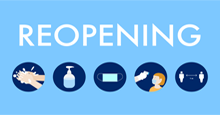Preparing for Reopening from COVID-19
Body
NCHYF COVID-19 Technical Work Group Contributors: Danny Balkcom; Thomas Bonnington; Rebecca Eichelberger, PhD; and Areon Kelvington
As the country begins to reopen after months of COVID-19 closures, every state looks a little different. There are several common considerations that all youth service organizations should know as normal activity slowly resumes. Fortunately, there are federal guidelines for the phases which can help your organization prepare and tap into resources to learn more.
What do the phases of reopening look like?
The federal guidelines dictate three phases of reopening to guide Americans safely back to more normal activity. No matter the phase, until we have a cure or vaccine, we are still experiencing a public health crisis that requires everyone to be cautious and take precautions to prevent transmission of the virus.
Phase One
Phase One encourages vulnerable groups, including anyone with high blood pressure, chronic lung disease, diabetes, obesity, or asthma, to continue socially isolating.
- Individuals should continue to practice distancing and avoid unnecessary travel.
- Businesses are encouraged to continue teleworking where possible, bring people back to the office in phases, close off common areas, and encourage distancing in the office.
- Schools and youth activities are still recommended to be closed in Phase One, and large venues are encouraged to only reopen if strict distancing can be implemented.
Phase Two
In Phase Two, vulnerable groups should continue to isolate as much as possible.
- Individuals are encouraged to continue distancing and to avoid social settings of more than 50 people.
- Businesses have similar guidance – encourage continued teleworking where possible, close common areas in the office, and encourage distancing.
- Schools and youth activities can begin to reopen, with distancing and sanitation measures in place.
Phase Three
In Phase Three, vulnerable groups can resume public interactions with appropriate distancing and exposure precautions.
- Individuals are encouraged to minimize time spent in crowded environments.
- Businesses can resume normal operations.
- Large venues can operate with less strict distancing.
What should youth service organizations do?
When planning for each phase of reopening, you should follow the guidance of your state and local health department website. Regardless of where your state is in the reopening process, there are several overall suggested precautions you can take to keep both staff and youth safe.
Communication
- Stay up to date with your state and local health department and communicate frequently with your staff.
- Use posters in strategic places to promote handwashing, cough and sneeze etiquette, face coverings, and social distancing (the CDC has posters you can use for free on their site).
- Communicate with your staff and clients about stress related to COVID-19 and ways to manage it.
Safety at Work
- Set up workstations and common areas that allow everyone to keep physical distance from each other.
- Require staff and the people you serve to wear masks or cloth face coverings.
- Provide easy access to handwashing facilities.
- Clean and disinfect facilities regularly.
- Take extra precautions to protect high-risk staff members.
Protecting Those You Serve
- Work with your local health department to identify the best ways to continue protecting people who are unsheltered or staying in encampments.
- Continue to evaluate clients for COVID-19 symptoms and connect them to medical care.
- Work with community coalitions to safely isolate, quarantine, or provide medical care for people who are suspected or confirmed to be positive for COVID-19.
- Take extra precautions for people you serve who may be high-risk.
- Consider how to safely resume any services that you may have stopped – specifically, restart mental health and substance use services as quickly as possible when prevention strategies are in place.
You can find more information about all of these suggestions on the CDC’s Checklist for Homeless Service Providers During Community Re-opening.
Where can you find more information?
Looking for more COVID-19 resources to help your organization plan for reopening? Check out the following pages for more information:
